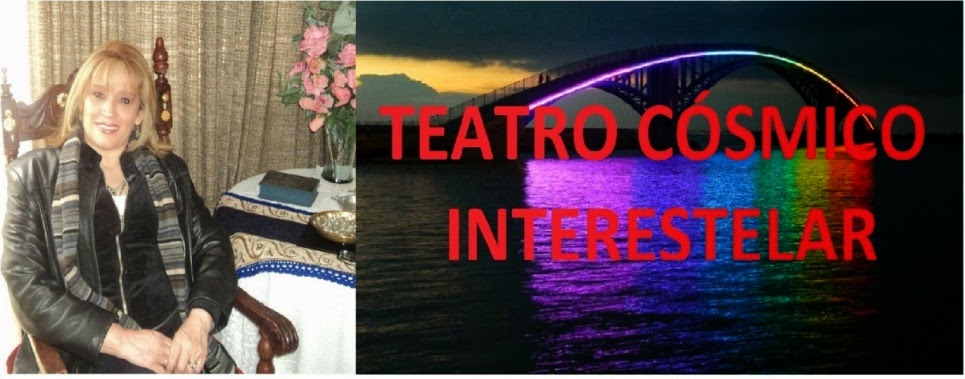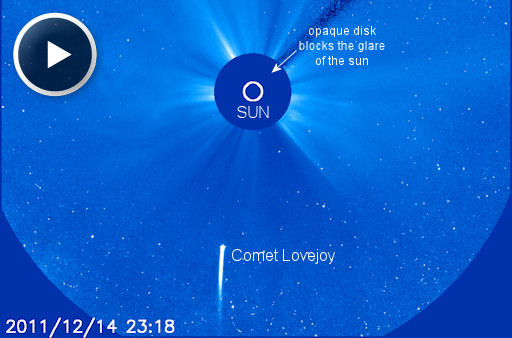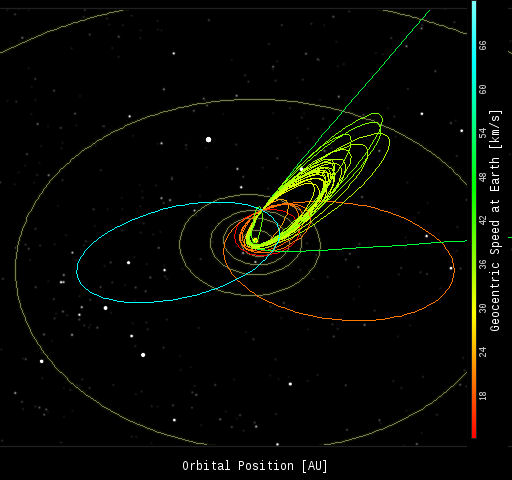| Thursday, Dec. 15, 2011 | ||||
| What's up in space | ||||
CURIOSITY
AND THE SOLAR STORM: Last month,
a massive solar storm launched itself toward Mars
just as NASA's new rover, Curiosity, was blasting
off from Cape Canaveral in the same direction. Researchers
say it was a welcome coincidence. For the first
time in Mars-rover history, Curiosity is equipped
to study solar storms, and it will be monitoring
space weather all the way to the Red Planet. [full
story]
BIG
COMET PLUNGES TOWARD THE SUN: Comet
Lovejoy (C/2011 W3) is diving into the sun and furiously
vaporizing as it approaches the stellar surface.
The Solar and Heliospheric Observatory (SOHO) is
recording the kamikaze plunge:
"This is, without any doubt,
the brightest sungrazing comet that SOHO has ever
seen," says comet researcher Karl Battams of
the Naval Research Lab in Washington DC.
The comet's nucleus, thought to be
twice as wide as a football field, will skim approximately
140,000 km (1.2 solar radii) above the solar surface
on Dec. 15/16. At such close range, solar heating
will almost certainly destroy the comet's icy core,
creating a cloud of vapor and comet dust that will
reflect lots of sunlight.
"If Comet Lovejoy gets as bright as magnitude
-4 or -5, there is a tiny but non-zero chance that
it could become visible in the sky next to the sun,"
says Battams.Indeed, something similar happened to Comet McNaught in January 2007 when it was visible in broad daylight: gallery. Standing in the shadow of a tall building to block the sun allowed the comet to be seen in blue sky nearby. "Comet Lovejoy will be reaching perihelion (closest approach to the sun) right around sunset on Dec. 15th for people in the US East, Central, Mountain, and Pacific time zones," continues Battams. "Be alert for the comet to the left of the sun at that time." Caution: Do not look at or near the sun through unfiltered optics; focused sunlight can seriously damage your eyes.
Discovered
on Dec. 2nd by amateur astronomer Terry Lovejoy
of Australia, the comet is an unusually large member
of the Kreutz family. Kreutz sungrazers are fragments
of a single giant comet (probably the Great Comet
of 1106) that broke apart back in the 12th century.
SOHO sees one plunging into the sun every few days,
but most are small, no more than 10 meters wide.
Comet Lovejoy is at least ten times larger than
usual.
Got pictures of Comet Lovejoy? Submit
them here.
GEMINID
FIREBALLS: On the night of Dec.
13/14, NASA's All-Sky
Meteor Network recorded 35 fireballs streaking
over the southern USA. Twenty-two of them had remarkably
similar orbits:
The clustered green orbits match the
trajectory of near-Earth asteroid 3200 Phaethon,
source of the annual Geminid meteor shower. The
Geminids have been active this week as Earth passes
through the asteroid's mysterious
debris stream. The other, non-Geminid orbits correspond
to random meteoroids. Not belonging to any organized
debris stream, random meteoroids litter the inner
solar system and produce a daily drizzle of "sporadic"
fireballs.
NASA's fireball network, which connects
multiple cameras in New Mexico, Alabama, Georgia
and Tennessee, is a "smart" system. It
rapidly and autonomously calculates meteoroid orbits
from the fireballs it records. Another orbit diagram
is just hours away; stay tuned.
more Geminids: from
Fredrik Broms of Kvaløya, Norway; from
Paul Martin of Omagh, Co Tyrone N.Ireland; from
Salvador Aguirre of Hermosillo, Sonora, Mexico;
from
Mike Hankey of Freeland, Maryland; from
Ugur Ikizler of Kirazlı - Uludag - Bursa / Turkey
|




No hay comentarios:
Publicar un comentario